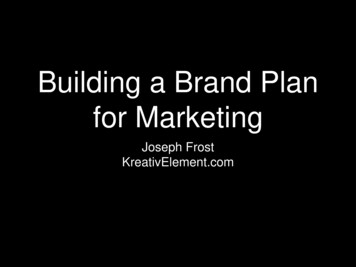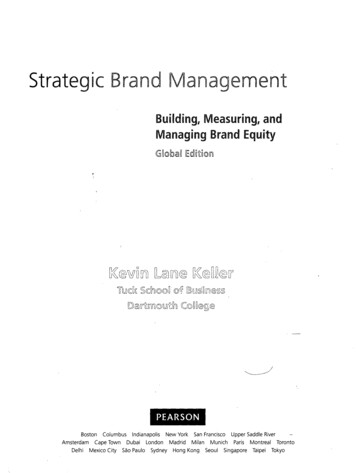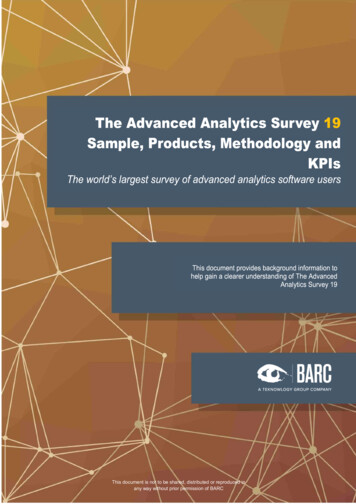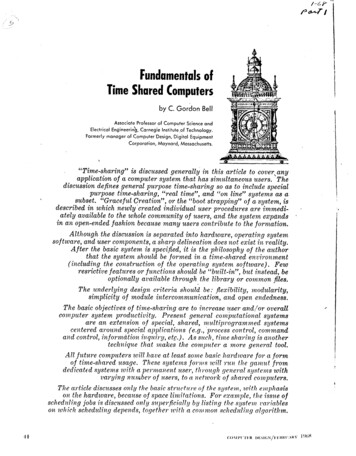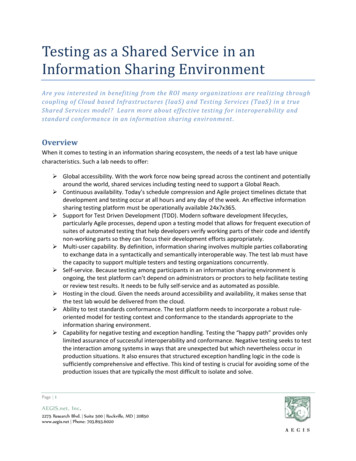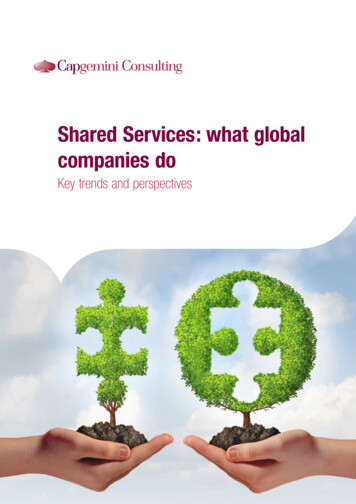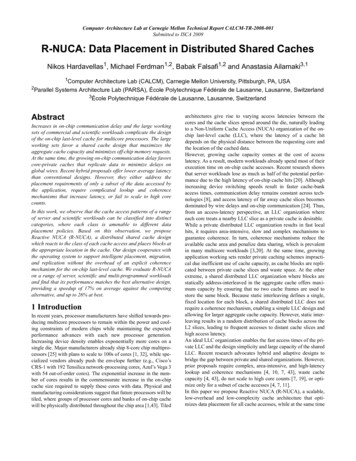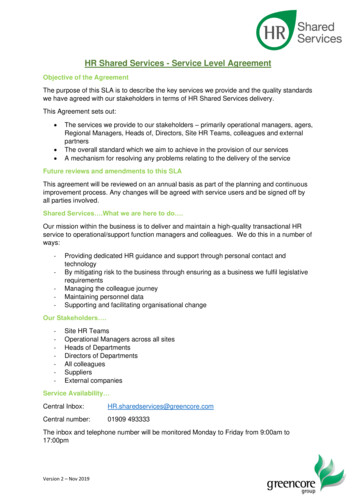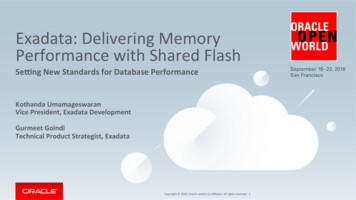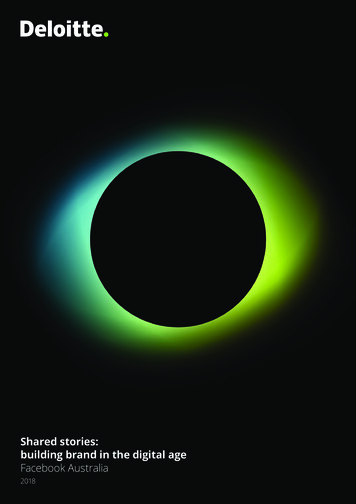
Transcription
Shared stories:building brand in the digital ageFacebook Australia2018
Limitation of our workGeneral use restrictionThis report is prepared solely for the use of Facebook Australia.This report is not intended to and should not be used or reliedupon by anyone else and we accept no duty of care to any otherperson or entity. The report has been prepared for the purposeof exploring how businesses are able to build strong brands in thedigital age. You should not refer to or use our name or the advicefor any other purpose
ContentsExecutive summary 11. Introduction 52. Businesses are not all recognising the value of brand82.1 The value of brands 82.2 Business underestimating the importance of brand82.3 Brand performance has been mixed93. Why are some businesses lagging behind? 113.1 Consumers are not where they used to be113.2 The fight for attention is real113.3 Difficulties measuring effectiveness across different touchpoints133.4 Structures and incentives are often not aligned143.5 Short-term business focus comes at the expense of the long term154. Marketers recognise the need for change 175. Reaping the rewards of digital marketing 205.1 A stronger brand 215.2 Increased sales and revenue 225.3 Building customer interactions235.4 Reaching and targeting specific markets235.5 Repositioning a brand 246. Top tips for marketing strategies 25References 27Appendix A Marketing professionals survey 29Contact Us31
Shared stories FacebookExecutive summaryAustralian businesses are notall recognising the value of brand.It is difficult to precisely measure the value of a brand.So why are some Australian businessesHowever, there can be no doubt that brands canlagging behind?create significant value for a company.With a continually evolving landscape, the basicprinciples of marketing are being updated. We foundStrong brands create emotional connections betweenfive trends that are shifting the paradigm and shapinga business and its customers. This can generatewhat businesses need to do to successfully buildsubstantial value; the top 100 brand assets ina brand.Australia were worth a total of 143 billion in 2017(Brand Finance Australia, 2017).Consumers are not where they used to be.A single channel, mass-broadcast approach no longerBusinesses that have strong brands are alsohas the same reach. For example, even over the lastsignificantly more profitable. In the year to 2017,year, the average time that people spend watchingthe 100 businesses with the most valuable brandsbroadcast TV has decreased by 8%. In some groups,in US had net profits rates 42.9% higher than overallthe trend is even stronger; 25-34 year olds todayS&P 500 (Millward Brown, 2017).watch 17% less TV than they did just one year agoYet despite its importance and clear value to abusiness, a fresh survey commissioned for this reportOn the other hand, consumption of other mediafound that only 17% of Australian marketers see brandis increasing; consumers are now spending almostas their most important objective.3 hours a day viewing content on their phonesFailing to recognise the importance of brand comes(Oztam, 2018).at a cost. We found that businesses whose brandsBrands have always needed to be where theirstagnated over the past year also saw their revenuesaudiences are most present. With the rapid changefall by 13% on average over this period. For a businessin consumer behaviour, marketers need to developwith annual revenue of 1 billion, this represents aadditional techniques for expanding their brandpotential fall of 130 million in revenue.strategies to engage with an increasingly mobileSuccessful brands bring broader benefits thanjust revenue. They can translate to better productdifferentiation, customer loyalty, staff attraction andpremium pricing.In this context, Facebook has engaged Deloitte toexplore why brand is being overlooked, and highlighthow businesses can build a brand in today’smodern world.1(Oztam, 2018).and social audience.
Shared stories FacebookThe fight for attention is real.As well as structuring the organisation appropriately,Consumers’ attention spans have shortened.decision-making must be shared to enable a brandto be nimble and responsive. We found that 61% ofMore than three-quarters (76%) of Australians watchmarketing strategies had to be approved by the CEO.TV and use the internet simultaneously (Oztam, 2016).While this is one way to deliver consistency, it createsBuying an advertising slot on prime time TV doesn’tadditional time consuming layers of approval and canguarantee that consumers will hear the message.take consumer marketing decisions out of the handsMaintaining consumer attention is getting harder onevery screen. When given a choice, 77% of viewerswill skip an advertisement played before a video(Deloitte, 2017).To cut through, brands need to rethink the way theytell stories, and consider omni-channel approaches.Difficulties measuring effectiveness acrossdifferent touchpoints.Leading companies use a combination of traditionaland digital techniques to better measure successagainst a core objective. But there is a long way to go.Less than half of the businesses surveyed (44%) usecross-channel measurement to quantify marketingsuccess. This could create misunderstandings of whatis actually driving impact, hindering future planning.Nearly 58% of businesses see the inability to measureacross channels as the highest barrier to developingmore effective campaigns. Yet businesses understandits importance – accurate measurement acrosschannels is expected to be the number one driverof change in marketing strategy in the future.of the individuals best qualified.Short-term business focus comes at the expenseof the long term.A brand is not built in one campaign, nor is its impactseen immediately. Businesses that focus only onshort-term or direct impacts miss an evolvingrelationship that builds with consumers over time.In fact, we find that businesses who focus on longterm metrics are 1.3 times more likely to experiencean improvement in their brand performance thancompanies which only measure short-term sales.Our survey showed that 68% of businesses areusing campaign specific sales metrics (such as ROI)as one of their measures of overall marketing success.Focusing heavily on short-term metrics means thatsome businesses are potentially optimising theirwork towards the wrong signals.Ultimately, businesses need to use short- and longterm metrics together. Short-term metrics shouldguide more tactical elements such as creative, whilelonger-term measures can inform strategic directionand budgeting.Structures and incentives are often not aligned.Organisations and their agency partners must be setup in a way so that they can best understand, reactand communicate to consumer needs. Product siloesare creating inconsistent and sometimes wastefulmarketing messages. In our case studies, we found thatANZ had seen a dramatic improvement in their brandperformance by restructuring their teams and agenciesto be more consumer focused.2
Shared stories FacebookThere is a desire and recognition that changemust happen.More than three-quarters of surveyed marketingprofessionals (78%) identified having an effectiveomni-channel approach and measuring itsoutcomes as crucial for future success.And for good reason. A well-executed advertisingcampaign across 4 or more channels, all wellintegrated, is 27% more effective at deliveringbrand impact (KMB, 2018).Those taking the steps are reaping the rewards.Digital and social media are platforms where you canbuild brands where consumer attention is, but alsoenable businesses to communicate in new ways.More than half (51%) of Australians agree that abusiness’s use of social networking sites has improvedtheir perceptions of the company or brand (Deloitte2016). Our survey revealed that businesses that spentan above-average proportion of their marketing budgeton social media reported 7% more revenue growthon average.If marketers fail to adapt to these changes or recognisethe opportunities, they risk diminishing returns on theirtried and tested brand strategies, which in the longterm will affect their business. With 28% acknowledginga decline in their brand value in the last 12 months,this is a trend we are already seeing.Businesses in today’s highly competitive marketcannot afford for their brands to stagnate.In the paper we explore these themes in moredepth and outline steps to ensure your businessremains relevant.3
Shared stories Facebook1. IntroductionA well-developed brand can help a business to differentiate theirproducts, create and maintain a reputation, and build customerloyalty. To reap these benefits, businesses need to understandhow to develop their brand in a changing environment.The value of a brand is determined by a number ofThis involved a new, bespoke survey of 300 marketingfactors – from product quality and customer serviceprofessionals from Australia and New Zealand. One-through to logos and trademarks. One key contributoron-one interviews were also held with Chief Marketingto brand is marketing and communications. This is oneOfficers at various stages of the brand developmentof the primary ways that businesses communicate theirjourney along with a workshop with senior marketingstory with both existing and potential customers.executives from advertising agencies and business.Yet the marketing industry is changing rapidly.The remainder of the report is structured as follows:New technology means there are new channels whichoffer different ways for engaging with customers.And just over the horizon, marketers are expectingthat new methods to measure their own success willdrive their marketing strategy. Chapter 2: demonstrates that businessesare not paying enough attention to their brand Chapter 3: explores the reason why Australianbusinesses are lagging behind in brand development Chapter 4: analyses how marketers are trying toMarketing professionals that do not keep pace withkeep up with the latest developments in technologythese trends risk a stagnating brand. Chapter 5: provides a business case for using digitalIn this context, Facebook Australia has engaged Chapter 6: identifies tips for organisations to enableand social media channels to build brandDeloitte to explore how a business can effectively buildeffective brand building in the digital age.a brand in a digital age. This report explores this topicusing a mixture of academic research and new data.Survey of marketing professionalsThis document presents fresh insights into marketing strategies, the views of marketers andhow businesses are building brands today. This is based on a bespoke survey of 300 marketingprofessionals from Australia and New Zealand.The survey questions were intended to provide insights into: current marketing activities recent performance of their marketing activities and brand their top marketing objectives the role of different channels in theirmarketing mix future trends in the marketing profession.The survey was a Computer Aided Telephone Interview (CATI) was by IPSOS Australia betweenFebruary and March 2018. Respondents were marketing managers, marketing directors,or chief marketing officers. Further details about the survey are available in Appendix A.5
Shared stories FacebookCASE STUDYFinding new customers at KathmanduKathmandu is a 30 year old travel and adventure brand,born in Christchurch, New Zealand. As Kathmandu has grown, its groupof loyalists have aged too, most notably people over 45 years of agewho are outdoor enthusiasts and now have families. The challenge forKathmandu was to appeal to new audiences of younger adventurers.Competition in the outdoor industry is fierce, withFrom a communications planning and channelstrong technical and environmental credentialsstandpoint, Kathmandu needed media efficiencyacross the industry. Kathmandu needed to refine itswith mass reach to younger (new) and older (existing)positioning and find a path to connecting with the nextaudiences. With people spending more time on mobilegeneration of adventure travellers. It also needed anand with a specific audience in mind, Kathmanduagile way to scale beyond its home markets in Australialeveraged digital channels to connect with existingand New Zealand.and potential customers. In retail, this all needed to betied back to sales and specific brand and media spendDigital transformation has provided compellingeffectiveness. One of the truly compelling elements ofopportunities to reach these new audiences.Kathmandu’s mobile-led digital journey has been itsKathmandu’s purpose – to provide people with theability to tie specific activities to commercial outcomes,confidence to discover the World – was critical toboth online and instore.land first. The creative challenge was to resonate withthe desired emergent audience, without alienatingKathmandu’s most loyal “Summit Club” members.Kathmandu worked closely with Facebook’s creativeteam to understand how these audiences connectedwith brands on its mobile platforms, as a means ofinforming their creative process.Digital tools, analytics and partners have helpedKathmandu better understand its customer segments,which proved useful in guiding its positioning andcommunications strategy.6
Shared stories FacebookCONSUMERDEMAND58%see the inability to measure acrosschannels as a barrier to makingmore effective campaigns7
Shared stories Facebook2. Businesses arenot all recognisingthe value of brandBrands are a significant source of value and deliver substantialbenefits for a business. Yet many marketers and businessesare underestimating the importance of brand.Our survey found that only one in five (17%)Investment in brand can have large financialmarketers believe that building brand is the mostimplications for a business. Our survey found thatimportant objective of their marketing strategy.those businesses whose brand performance hadPerhaps as a result of this lack of focus, over one-stagnated over the past year saw their revenues fallquarter of marketers think that their brand hasby 13% on average. This represents 130 million instagnated or declined over the last twelve months.foregone annual revenue for a business with annual2.1 The value of brandsrevenue of 1 billion.A well-developed brand can be very valuable to aThe converse is also true. In the year to 2017, thebusiness. Brand Finance Australia (2017) estimates100 businesses with the most valuable brands inthat the top 100 brands in Australia were worthUS had net profits rates 42.9% higher than overalla total of 143 billion in 2017. This is almost halfS&P500 (Millward Brown, 2017). Stronger brands can(45%) the value of the intangible assets of the 1000generate increased profits, enable greater productlargest companies in 2016 (Deloitte analysis baseddifferentiation, customer loyalty, talent attractionon IBISWorld 2017).and even justify premium pricing.Even this estimate does not capture the full value of2.2 Business underestimating thebrand. Research by Deloitte has revealed businessesimportance of brandmay be underestimating the true value of theirDespite the value of brands, many marketers are notbrand. Existing accounting frameworks only valueprioritising brand in their marketing strategy. Only oneintangible assets acquired through purchasing, whilein five (17%) say that building brand is the mostomitting those developed internally. For ASX200 listedimportant objective of their marketing strategycompanies, this omits an average of 48% of the value(Chart 2.1), with many citing increasing sales andof the company (Deloitte, forthcoming). Indicativerevenue, building customer engagement andresearch amongst non-executive directors indicatesincreasing market share as equally or morethat over 70% of boards are not informed of brandimportant than building brand.value on an annual basis (Deloitte, forthcoming). Bettervisibility over assets such as brand would lead to moreappropriate management and investment in thesedifficult to measure assets.8
Shared stories Facebook2.3 Brand performance has been mixedBrands are also struggling to create an emotionalPerhaps as a result of this lack of emphasis on brand,connection with consumers. For example, mostmany brands today are performing poorly.consumers wouldn’t care if three out of four brandsthey use every day disappeared (Meaningful brands,Our survey of marketing professionals shows that2017). Forging an emotional connection requiresbrand performance over the past 12 months has beenbrands to understand and reflect the core values heldsomewhat lacklustre. Over one quarter of marketersby their customers (Deloitte, 2018). In the digital age,(28%) think that their brand has stagnated or declinedthis requires not only messages that are relevant butduring this time, as shown in Chart 2.2. This is highalso relevant methods of delivery.considering it is a self-assessed measure.Chart 2.1: Top marketing objectives for marketing professionals25%23%20%18%17%17%15%10%Chart 2.1Top marketingobjectives formarketingprofessionals.Source: Deloitteanalysis & IPSOS(2018)7%5%0%Increasing salesand itioninga t 2.2Change in brandperformanceover the last12 months.Source: Deloitteanalysis & IPSOS(2018)9Strongly improvedSomewhat improved47%No changeSomewhat declined4%4%MaintainingmarketshareAchievinga selectedreturn oninvestment
Shared stories FacebookBRANDS AREDECLINING1/5onlysay that building brandis the most importantobjective of their strategy10
Shared stories Facebook3. Why are businesseslagging behind?With a continually evolving landscape, the basic principles of marketingare being updated. We found five trends that are shifting the paradigmand shaping what businesses need to do to successfully build a brand.3.1 Consumers are not where they used to be3.2 The fight for attention is realA single channel mass broadcasting approach cannotConsumers attention spans have shortened. We arereach a brand’s entire audience anymore. For example,subject to more information than ever before;the average time spent viewing broadcast TV peron average, we consume over 5,000 advertisementsmonth has declined 8% in the past 12 months. Yetevery day (Media Dynamics, 2014). The volume ofeven this masks strong declines in certain age groupsinformation makes it harder to cut through,such as the 25-34 year olds who watched 17% less onwith only 12 of the 5,000 advertisements makingaverage than 12 months ago (Oztam, 2018).an impression (Media Dynamics, 2014).On the other hand, today 88% of Australians ownEven a best-in-class campaign in a medium mighta smartphone (Deloitte, 2017), and on average, wenot be enough to capture attention, as a consumer’sspend 3 hours on our phones every day (Oztam, 2018).attention is divided amongst multiple screens. MoreSimilarly, nearly 80% of Australians now use socialthan three-quarters (76%) of Australians watch TVmedia (Sensis, 2017).and use the internet simultaneously (Oztam, 2016).Artificial intelligence enabled voice assistants provideMulti-screening means that brands need to competea new interface for businesses to interact withacross channels. For example, Chart 3.1 shows thatcustomers. While the technology is still in early stages,consumers may shift their attention to other mediumsit is anticipated that voice activated interactions willduring commercial breaks.grow exponentially. Already, 45% of adults have accessto voice assistants, with 37% of them using these voiceMaintaining consumer attention is getting harder onassistants daily (Forrester, 2017, Gartner, 2017).every screen. When given a choice, 77% of viewerswill skip an advertisement played before a videoWith the rapid change in technology and consumer(Deloi
substantial value; the top 100 brand assets in Australia were worth a total of 143 billion in 2017 (Brand Finance Australia, 2017). Businesses that have strong brands are also significantly more profitable. In the


